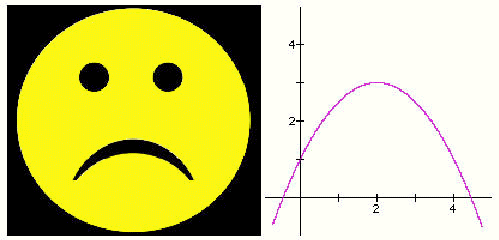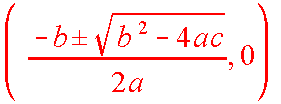|
An Overview The general or standard form of a quadratic function is y = ax2 + bx + c, or in function form, f(x) = ax2 + bx + c, where x is the independent variable, y is the dependent variable, and a, b, and c are constants. Another important form of equation used is the vertex form, y = a(x - h)2 + k, where (-h, k) is the vertex of the parabola. In both forms, a determines the size and direction of the parabola. The larger the absolute value of a, the steeper (or thinner) the parabola is, since the value of y is increased more quickly. All parabolas are actually similar in a geometric sense, just as all circles and squares are similar figures, with apparent size determined by the constant a. If a is positive, the parabola opens upward, if negative, the parabola opens downward.  a is positive  a is negative The y-intercept : y = ax2 + bx + c Given , the y-intercept is c. The x intercepts : Given , the x-intercepts are the solutions to the equation : ax2 + bx + c = 0 The most common methods to solve this equation are by factoring, completing the square, or by the quadratic formula. The Quadratic Formula : For any function in the form y = ax2 + bx + c, x-intercepts are given by : 
The discriminant, b2 - 4ac, is often used to determine if there are x-intercepts (also called the roots of the function) . If the discriminant is negative then there are no x intercepts (can't take square root of a negative number) and the results are imaginary numbers. Finding the Vertex For a quadractic equation in the form : y = ax2 + bx + c the x value of the vertex (minimum or maximum) is -b/2a. We can then take this value and plug it into the x variables of our equation to find the y value of the vertex. |